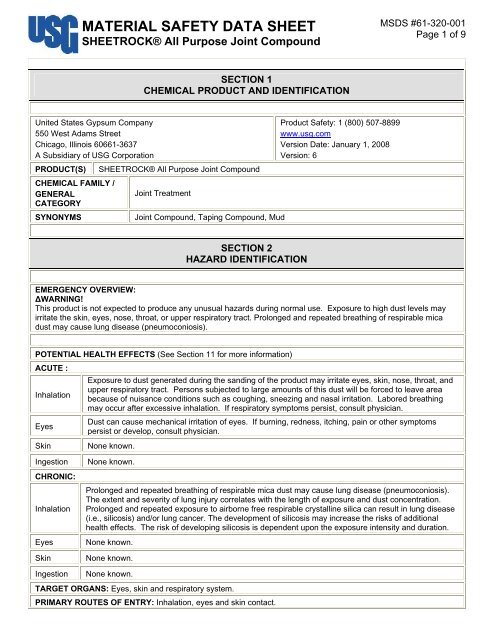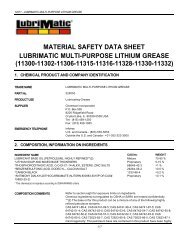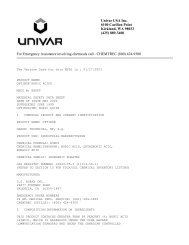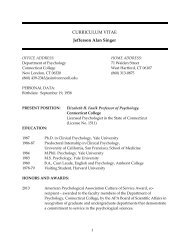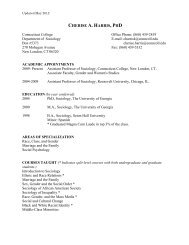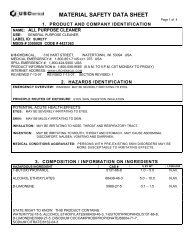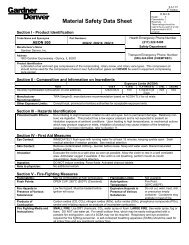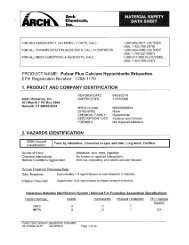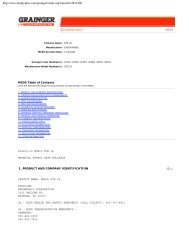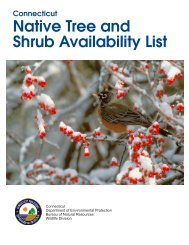SHEETROCK All Purpose Joint Compound 61320001v6
SHEETROCK All Purpose Joint Compound 61320001v6
SHEETROCK All Purpose Joint Compound 61320001v6
You also want an ePaper? Increase the reach of your titles
YUMPU automatically turns print PDFs into web optimized ePapers that Google loves.
MATERIAL SAFETY DATA SHEET<strong>SHEETROCK</strong>® <strong>All</strong> <strong>Purpose</strong> <strong>Joint</strong> <strong>Compound</strong>MSDS #61-320-001Page 1 of 9<strong>SHEETROCK</strong> <strong>All</strong> <strong>Purpose</strong> <strong>Joint</strong> <strong>Compound</strong> <strong>61320001v6</strong>SECTION 1CHEMICAL PRODUCT AND IDENTIFICATIONUnited States Gypsum Company550 West Adams StreetChicago, Illinois 60661-3637A Subsidiary of USG CorporationPRODUCT(S) <strong>SHEETROCK</strong>® <strong>All</strong> <strong>Purpose</strong> <strong>Joint</strong> <strong>Compound</strong>CHEMICAL FAMILY /GENERALCATEGORYSYNONYMS<strong>Joint</strong> Treatment<strong>Joint</strong> <strong>Compound</strong>, Taping <strong>Compound</strong>, MudProduct Safety: 1 (800) 507-8899www.usg.comVersion Date: January 1, 2008Version: 6SECTION 2HAZARD IDENTIFICATIONEMERGENCY OVERVIEW:ΔWARNING!This product is not expected to produce any unusual hazards during normal use. Exposure to high dust levels mayirritate the skin, eyes, nose, throat, or upper respiratory tract. Prolonged and repeated breathing of respirable micadust may cause lung disease (pneumoconiosis).POTENTIAL HEALTH EFFECTS (See Section 11 for more information)ACUTE :InhalationEyesSkinExposure to dust generated during the sanding of the product may irritate eyes, skin, nose, throat, andupper respiratory tract. Persons subjected to large amounts of this dust will be forced to leave areabecause of nuisance conditions such as coughing, sneezing and nasal irritation. Labored breathingmay occur after excessive inhalation. If respiratory symptoms persist, consult physician.Dust can cause mechanical irritation of eyes. If burning, redness, itching, pain or other symptomspersist or develop, consult physician.None known.IngestionCHRONIC:InhalationEyesSkinNone known.Prolonged and repeated breathing of respirable mica dust may cause lung disease (pneumoconiosis).The extent and severity of lung injury correlates with the length of exposure and dust concentration.Prolonged and repeated exposure to airborne free respirable crystalline silica can result in lung disease(i.e., silicosis) and/or lung cancer. The development of silicosis may increase the risks of additionalhealth effects. The risk of developing silicosis is dependent upon the exposure intensity and duration.None known.None known.Ingestion None known.TARGET ORGANS: Eyes, skin and respiratory system.PRIMARY ROUTES OF ENTRY: Inhalation, eyes and skin contact.
MATERIAL SAFETY DATA SHEET<strong>SHEETROCK</strong>® <strong>All</strong> <strong>Purpose</strong> <strong>Joint</strong> <strong>Compound</strong>MSDS #61-320-001Page 2 of 9CARCINOGENICITY CLASSIFICATION OF INGREDIENT(S) <strong>All</strong> substances listed are associated with the nature ofthe raw materials used in the manufacture of this product and are not independent components of the productformulation. <strong>All</strong> substances, if present, are at levels well below regulatory limits. See Section 11: ToxicologyInformation for detailed information.MATERIAL IARC NTP ACGIH CAL- 65Crystalline silica 1 1 A2 ListedIARC - International Agency for Research on Cancer: 1- Carcinogenic to humans; 2A – Probably carcinogenic tohumans; 2B – Possibly carcinogenic to humans; 3 - Not classifiable as a carcinogen; 4 – Probably not a carcinogenNTP – National Toxicology Program (Health and Human Services Dept., Public Health Service, NIH/NIEHS): 1-Known to be carcinogen; 2- Anticipated to be carcinogensACGIH – American Conference of Governmental Industrial Hygienists: A1 – Confirmed human carcinogen; A2 –Suspected human carcinogen; A3 – Animal carcinogen; A4 - Not classifiable as a carcinogen; A5 – Not suspected asa human carcinogenCAL-65 – California Proposition 65 “Chemicals known to the State of California to Cause Cancer”Respirable crystalline silica: IARC: Group 1 carcinogen, NTP: Known human carcinogen. The weight percent ofcrystalline silica given represents total quartz and not the respirable fraction. The weight percent of respirable silicahas not been measured in this product.Food and Drug Administration [CFR Title 21, v.3, sec 184.1409] – Ground limestone is Generally Recognized as Safe(GRAS).POTENTIAL ENVIRONMENTAL EFFECTS: This product has no known adverse effect on ecology. (See Section 12for more information)SECTION 3COMPOSITION, INFORMATION ON INGREDIENTSMATERIAL WT% CAS #Limestone >65Or DolomiteMica
MATERIAL SAFETY DATA SHEET<strong>SHEETROCK</strong>® <strong>All</strong> <strong>Purpose</strong> <strong>Joint</strong> <strong>Compound</strong>MSDS #61-320-001Page 3 of 9SkinWash with mild soap and water. If irritation persists, consult physician.IngestionThis product is not intended to be ingested or eaten. If gastric disturbance occurs, call physician.MEDICAL CONDITIONS WHICH MAY BE AGGRAVATED: Pre-existing upper respiratory and lung diseases suchas, but not limited to, bronchitis, emphysema and asthma. Pre-existing skin diseases such as, but not limited to,rashes and dermatitis.NOTES TO PHYSICIAN: Treatment should be directed at the control of symptoms and the clinical condition.SECTION 5FIRE FIGHTING MEASURESGeneral Fire HazardsExtinguishing MediaNone knownWater or use extinguishing media appropriate for surrounding fire.Special Fire Fighting Procedures Wear appropriate personal protective equipment. See section 8.Unusual Fire/Explosion HazardsHazardous Combustion ProductsNone knownAbove 800º C – limestone may decompose to calcium oxide (CaO) andcarbon dioxide (CO2).Flash Point Not Determined Auto Ignition Not ApplicableMethod UsedUpper Flammable Limit (UFL)Not ApplicableNot DeterminedFlammabilityClassificationNot ApplicableLower Flammable Limit (LFL) Not Determined Rate of Burning Not ApplicableSECTION 6ACCIDENTAL RELEASE MEASURESCONTAINMENT: No special precautions. Wear appropriate personal protective equipment. See section 8.CLEAN-UP: Use normal clean up procedures. No special precautions.DISPOSAL: Follow all local, state, provincial and federal regulations. Never discharge large releases directly intosewers or surface waters.SECTION 7HANDLING AND STORAGEHANDLING: Avoid dust contact with eyes. Wear the appropriate eye protection against dust (See Section 8).Minimize dust generation and accumulation. Avoid breathing dust. Wear the appropriate respiratory protectionagainst dust in poorly ventilated areas and if TLV is exceeded (see Sections 2 and 8). Use good safety and industrialhygiene practices.STORAGE: Store in a cool, dry, ventilated area away from sources of heat, moisture and incompatibilities (seeSection 10).
MATERIAL SAFETY DATA SHEET<strong>SHEETROCK</strong>® <strong>All</strong> <strong>Purpose</strong> <strong>Joint</strong> <strong>Compound</strong>MSDS #61-320-001Page 4 of 9SECTION 8EXPOSURE CONTROLS/PERSONAL PROTECTIONMATERIAL WT% TLV (mg/m 3 ) PEL( mg/m 3 )Limestone >65Or DolomiteMica
MATERIAL SAFETY DATA SHEET<strong>SHEETROCK</strong>® <strong>All</strong> <strong>Purpose</strong> <strong>Joint</strong> <strong>Compound</strong>MSDS #61-320-001Page 5 of 9Flash Point Not Determined Bulk Density ~ 40-80 lb/ft3Evaporation Rate (BuAc = 1) Not Applicable Molecular Weight MixtureUpper Flammable Limit (UFL) Not Determined VOC Content ZeroLower Flammable Limit (LFL) Not Determined Percent Volatile ZeroVapor Pressure (mm Hg) Not ApplicableSECTION 10CHEMICAL STABILITY AND REACTIVITYSTABILITYCONDITIONS TO AVOIDINCOMPATIBILITYHAZARDOUS POLYMERIZATIONHAZARDOUS DECOMPOSITIONStable.Contact with incompatibles (see below).None known.None known.Above 800º C – limestone may decompose to calcium oxide (CaO)and carbon dioxide (CO2).SECTION 11TOXICOLOGICAL INFORMATIONACUTE EFFECTS: None known.CHRONIC EFFECTS / CARCINOGENICITY:Mica: Prolonged and repeated breathing of respirable mica dust may cause lung disease (pneumoconiosis). Theextent and severity of lung injury correlates with the length of exposure and dust concentration.Crystalline Silica: Exposures to respirable crystalline silica are not expected during the normal use of this product;however, actual levels must be determined by workplace hygiene testing. The weight percent of respirable crystallinesilica may not have been measured in this product. Prolonged and repeated exposure to airborne free respirablecrystalline silica can result in lung disease (i.e., silicosis) and/or lung cancer. The development of silicosis mayincrease the risks of additional health effects. The risk of developing silicosis is dependent upon the exposureintensity and duration.In June, 1997, IARC classified crystalline silica (quartz and cristobalite) as a human carcinogen. In making the overallevaluation, the IARC Working Group noted that carcinogenicity in humans was not detected in all industrialcircumstances studied. Carcinogenicity may be dependent on inherent characteristics of the crystalline silica or onexternal factors affecting its biological activity or distribution of its polymorphs.IARC states that crystalline silica inhaled in the form of quartz or cristobalite from occupational sources is carcinogenicto humans (Group 1).SECTION 12ECOLOGICAL INFORMATIONENVIRONMENTAL TOXICITY: This product has no known adverse effect on ecology.
MATERIAL SAFETY DATA SHEET<strong>SHEETROCK</strong>® <strong>All</strong> <strong>Purpose</strong> <strong>Joint</strong> <strong>Compound</strong>MSDS #61-320-001Page 6 of 9Ecotoxicity valueNot determined.SECTION 13DISPOSAL CONSIDERATIONSWASTE DISPOSAL METHOD: Dispose of material in accordance with federal, state, and local regulations. Neverdischarge directly into sewers or surface waters. Consult with environmental regulatory agencies for guidance onacceptable disposal practices.SECTION 14TRANSPORT INFORMATIONU.S. DOT INFORMATION: Not a hazardous material per DOT shipping requirements. Not classified or regulated.Shipping NameHazard ClassUN/NA #Packing GroupLabel (s) RequiredGGVSec/MDG-CodeICAO/IATA-DGRRID/ADRADNRSame as product name.Not classified.None. Not classified.None.Not applicable.Not classified.Not applicable.None.None.SECTION 15REGULATORY INFORMATIONUNITED STATES REGULATIONS<strong>All</strong> ingredients of this product are included in the U.S. Environmental Protection Agency’s Toxic Substances ControlAct Chemical Substance Inventory.MATERIALWT%302304313CERCLACAASec. 112RCRACodeLimestone >65Or DolomiteMica
MATERIAL SAFETY DATA SHEET<strong>SHEETROCK</strong>® <strong>All</strong> <strong>Purpose</strong> <strong>Joint</strong> <strong>Compound</strong>MSDS #61-320-001Page 7 of 9SARA Title III Section 302 (EPCRA) Extremely Hazardous Substances: Threshold Planning Quantity (TPQ)SARA Title III Section 304 (EPCRA) Extremely Hazardous Substances: Reportable Quantity (RQ)SARA Title III Section 313 (EPCRA) Toxic Chemicals: X= Subject to reporting under section 313CERCLA Hazardous Substances: Reportable Quantity (RQ)CAA Section 112 (r) Regulated Chemicals for Accidental Release Prevention: Threshold Quantities(TQ)RCRA Hazardous Waste: RCRA hazardous waste codeCANADIAN REGULATIONSThis product has been classified in accordance with the hazard criteria of Controlled Product regulations and theMSDS contains all the information required by the Controlled Products Regulations. <strong>All</strong> ingredients of this product areincluded in the Canadian Domestic Substances List (DSL).MATERIAL WT% IDL Item #Limestone >65Or DolomiteMica
MATERIAL SAFETY DATA SHEET<strong>SHEETROCK</strong>® <strong>All</strong> <strong>Purpose</strong> <strong>Joint</strong> <strong>Compound</strong>MSDS #61-320-001Page 8 of 9INFORMATION FOR HANDLING AND IDENTIFICATION OF CHEMICAL HAZARDS0 = Minimal HazardHEALTHNFPA Ratings: 0* 1HIMS Ratings: 1 = Slight HazardFLAMMABILITY 0Health: 1 1 0 Health: 1 2 = Moderate HazardPHYSICAL HAZARD 0Fire: 0 Fire: 0 3 = Serious HazardReactivity: 0Reactivity: 0PERSONAL PROTECTION E 4 = Severe HazardE – Safety glasses, gloves and dust respiratorKey/LegendTLVThreshold Limit ValuePELPermissible Exposure LimitCASChemical Abstracts Service (Registry Number)NIOSH National Institute for Occupational Safety and HealthMSHA Mine Safety and Health AdministrationOSHA Occupational Health and Safety AdministrationACGIH American Conference of Governmental Industrial HygienistsIARC International Agency for Research on CancerDOT United States Department of TransportationEPAUnited States Environmental Protection AgencyNFPA National Fire Protection AssociationHMIS Hazardous Materials Identification SystemPPEPersonal Protection EquipmentTSCA Toxic Substances Control ActDSLCanadian Domestic Substances ListNDSL Canadian Non-Domestic Substances ListSARA Superfund Amendments and Reauthorization Act of 1986CAAClean Air ActEPCRA Emergency Planning & Community Right-to-know ActRCRA Resource Conservation and Recovery ActCERCLA Comprehensive Environmental Response, Compensation and Liability Act of 1980UN/NA# United Nations/North America numberCFRCode of Federal RegulationsWHMIS Workplace Hazardous Material Information SystemPrepared by:Product SafetyUSG Corporation550 West Adams StreetChicago, IL 60661-3637The information contained in this document applies to this specific material as supplied. It may not be valid for thismaterial if it is used in combination with any other materials. It is the user’s responsibility to satisfy oneself as to thesuitability and completeness of this information for his/her own particular use.
MATERIAL SAFETY DATA SHEET<strong>SHEETROCK</strong>® <strong>All</strong> <strong>Purpose</strong> <strong>Joint</strong> <strong>Compound</strong>MSDS #61-320-001Page 9 of 9END


